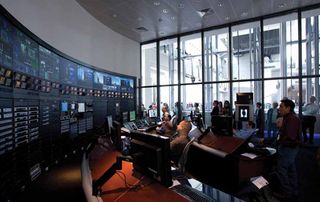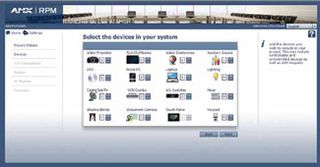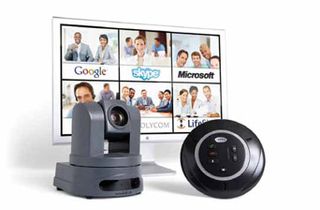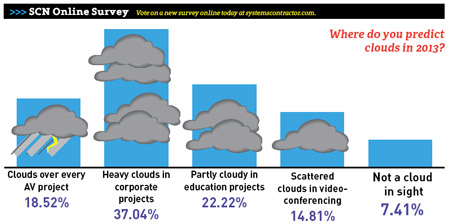Perhaps we won’t be going back to the moon anytime soon, but we are definitely headed to the cloud.
With clouds rolling in to capture videoconferencing, control, design, and integration applications, what is the forecast for traditional AV, in the short term and in the future?
Cloud computing is both a strong, important trend, and somewhat of a buzzword, said Peter Cherna, senior vice president of technology at Scala. “The value of cloud computing is that rich solutions can be deployed without worrying about the administrative complexity that sometimes goes hand in hand with the servers needed to coordinate those solutions.”
Within digital signage, he said, considerable success has been seen where the servers have been deployed traditionally on the customer’s premises, and increasingly where the servers are in the cloud. “Typically, a cloud-based solution is quick to set up, and often lets the customer and solutions partner focus more energy on the purpose, value, and experience of the signs, since the central infrastructure piece is essentially a given.”
For integrators, this means that organizations can outsource management of their rooms and equipment. “By moving to the cloud, the integrator doesn’t need to worry about opening up the client’s network to monitor or conduct maintenance,” said Fred Bargetzi, vice president of technology at Crestron. “It’s all done from the cloud. And that’s a huge benefit.”
Additionally, cloud-based solutions inherently represent an ongoing relationship for AV solution providers rather than a one-time sale, Cherna said. “That has important commercial characteristics, but in the long run it is an opportunity to reshape the overall customer relationship. A solution partner whose DNA already keeps them close to the customer over the long term will draw many benefits from the rhythm of the customer relationship that stems from a cloud-based solution.”
The premise of the cloud as an IT tool has three basic elements, the first of which is to remove or reduce the cost of expensive capital equipment that seldom reaches its full write-down depreciation before needing to be replaced, said Jim Carroll, executive vice president at Savant. “This model is exchanged for off-premise servers that you neither own nor maintain,” he said. “But rather you pay for the use of these servers that are the storage and computation engines of the cloud.”

Newseum uses Front Porch Digital’s DIVArchive to manage digital content. Front Porch Digital also offers a hosted solution that enables clients to ship data tapes to its facility for secured storage and, when required, the content management provider will make that content available online within 24 hours.Often, he said, these models are consumption based, with pay-as-you go usage, and cost-match utility. “This isn’t just related to hardware; the ability to have scalable, centrally managed, and collaborative software is a major driver for the cloud and has benefits for AV services.”
The second element is the ubiquitous nature of access to the resource, meaning that endpoint user devices have access to the services being rendered, i.e. Mac OS, Windows, Droid, or iOS devices, all able to access the cloud for services, anywhere, anytime, Carroll said. “Lastly, for data/document storage, the cloud maintains all the electronic information of an enterprise, with almost unlimited capacity and unmatched reliability.”
Upward Migration
For AV, the cloud computing and virtualization trends will present new modes of delivery for AV services, and just as desktop applications are migrating to network delivered services, AV services will do the same, said Joe Andrulis, vice president of marketing at AMX.
AMX’s RPM (Rapid Project Maker) is part of a larger plan to integrate products with the IT network more completely, and offer customers the advantages that networkcentric AV promises. “RPM is a cloud-based system design and programming application designed to allow AV systems for standard AV spaces like classrooms, conference rooms, and small auditoriums to be configured and programmed more rapidly, reliably, and with less training than ever before possible,” Andrulis explained.
With more and more organizations moving key operational functions to the cloud, the question is this: “What if you could do the same with all your AV systems?”
Organizations can monitor their AV and IT resources via mobile devices such as the iPad, iPhone, and Android devices, Bargetzi observed. “Maintenance can be conducted from anywhere, anytime, using these handheld devices, allowing organizations to reallocate resources to enhance worker productivity.”
With Crestron Connected, he said, it’s now possible to fully integrate your building’s AV systems with a network connection as part of the overall IT infrastructure. “The cloud-based architecture is revolutionizing the way organizations manage their AV systems enterprise-wide, moving to centralized monitoring, management, and control.”
An enterprise-wide solution can include hundreds of rooms with AV systems. “The first step is to connect them all to the corporate network,” Bargetzi said. “The second step is to select and implement the enterprise management tools that enable centralized monitoring and control, preventive maintenance, support upgrades, enhancements, and troubleshooting.”
Crestron’s Fusion enterprise platform, a server-based software package, enables centrally monitored and managed room scheduling, plus AV presentation and videoconferencing resources, all from the help desk. “Additionally, Fusion can manage and monitor renewable and sustainable energy sources in real time, displaying historical usage data for day, week, month, or year,” he said. “It also provides control of lighting, shades, and climate, enabling you to intelligently coordinate room scheduling and occupancy for greater energy savings.”

Cloud computing and virtualization trends present new modes of delivery for AV services. (Pictured: AMX Rapid Project Maker)To simplify installation and setup of Fusion, Crestron is moving it to the cloud. “When one of our AV dealers sells a system, rather than go through the IT department to set up servers, install Fusion, and get the system running, they’ll simply bring rooms online through Fusion in the cloud,” Bargetzi said. “The customer will then have their own private portal for managing and monitoring their overall AV and IT infrastructure.”
Additional customer benefits of moving to the cloud include lower total cost of ownership, easier deployment, SL A-level support, scalability and secure access from anywhere. “It will be seamless for someone to go from on-premise to cloud-based, utilizing Fusion,” he said. “There is no operational difference between cloudbased and on-premise. Appliance-grade devices in the room will never go to the cloud, but with Crestron we can move the control and management to the cloud.”
VC Calling
The AV industry always has been about creating products that satisfy customer demands for presenting, training, and conferencing, noted Vaddio president/ CEO, Rob Sheeley. “From our humble beginnings in film content, such as overheads and slide projectors, chalkboards, and presentation flip boards, we have always been driven by the media or by mediums that our customers adopt. Just imagine how small the projector industry would be had our customers not adopted PowerPoint as a presentation medium. Because they did, a projector now becomes a standard requirement for every meeting room.
“Videoconferencing—which started as a satellite point-to-point call, moved to a telco circuit switched network, and then to the IP video call—continues to be transformed by customer demands for higher quality mediums or content, from SD video to HD, and from low quality half duplex audio to wideband audio with echo-free calls,” Sheeley continued.
“Conferencing continues to be driven by our customers’ demands to communicate anywhere they want, at any time they want, and at whatever quality they want. As we were developing our EasyUS B AV products that allow a soft codec installed in a PC to become an enterprise-quality conferencing system, we knew that this would be a game changer for our industry. At the same time, we could also see the video calling limitations that some of these soft codecs had.”

When Vaddio customers buy an EasyUSB system they will get a free trial version of cloud services.After identifying videoconferencing cloud service providers that would allow all of these new soft codec systems to connect with anyone, Vaddio found that interoperability with legacy Polycom, Cisco/Tandberg, LifeSize systems, or different network platforms, in addition to bridging multiple callers together, would no longer be a problem.
“As a result, we decided to partner with two of the premier cloud service providers, Blue Jeans Network and Vidtel,” Sheeley explained. “When our customers buy an EasyUS B system they will get a free trial version of cloud services that will provide the chance to experience the enhanced service offerings they can expect from a cloud service provider.”
Savant has seen examples in the AV world of pseudocloud solutions, with videoconferencing coming to mind, Carroll said, “although it is more of a soft switch architecture similar to telecom, where many of us here have our backgrounds, and where we established ourselves as innovators in that space.”
With VC services, there is dedicated hardware that sits off-premise connecting many different specialized end-points. “Short of the ‘we don’t own the expensive hardware in the public internet’ element, the systems look very similar,” he said. “Software as a service (SaaS) systems also follow a very similar model and are heavily deployed with digital out of the home (DooH) service with digital signage. CRM systems such as SalesForce are another good example, along with a media player company called Autonomic Controls.”
As senior vice president of conferencing and collaboration for InterCall, the world’s largest conferencing services provider, Robert Bellmar said the company provides a comprehensive set of videoconferencing solutions ranging from desktop video to immersive telepresence. “We can deliver unequalled support and simplified execution to any sized organization,” he said. “We have been executing hosted solutions in video for almost 20 years. We see these and newer cloud conferencing solutions growing dramatically in the next five years, much like audio conferencing did 15 years ago.”

The cloud is expanding, continued Bellmar. “Initially accessed using video ISDN circuits, it then migrated to private/overlay networks tying into the cloud. The new cloud services allow the cloud to be accessed via the internet, plus they open up the device interoperability, making video conferences much easier to facilitate and bringing all sorts of users into the meeting.”
Clouds Forecasted
The cloud is going to grow and will enhance the ROI on equipment, Bellmar said. “The virtual walls of enclosed room collaboration are broken as the access to the cloud grows. Because of that, the barrier to sell should continue to decline, as ROI will be easier to come by. Add to that the expanded access to mobile and desktops, and the next five years will see tremendous growth in the number of users.”
This is especially true in the SME space, he said, where capital expenditures traditionally restricted their ability to use video. “Integrators should be embracing the cloud as a way to expand the use of video and extend the life of installed systems through a wider variety of devices and a larger universe of prospects.”
The next five years will bring a continued mix of cloud-based and on-premise solutions, although the balance will shift, in some cases quite quickly, Cherna said. “Scala’s product range includes our pure-cloud, easy SignChannel offering, while our flagship Scala 5 product is available with an on-premise server or with various hosted or cloud-based alternatives managed by Scala or by one of our many partners. In this way, we can offer flexible support for customers that are ready for cloud-based solutions, and also for those for whom the cloud is not, or not yet, the right choice.”
For AV solution providers, who are working very hard to help their customers with diverse needs, the emergence of strong cloud-based solutions can help by reducing the time and effort needed to support the server infrastructure, he said. “They also free up time that can be used to increase the scope and success of the solutions offered.”
Bargetzi sees more and more services going to the cloud. “We have been doing this since 1998 and we’re not slowing down. It’s surprising that the AV world has yet to fully embrace the cloud. Even though systems are networked within the room, they’re not integrated with the corporate network.
Non-cloud-based networking is not going away entirely, he said. “Organizations can have an internal cloud, also known as on-premise. Then there’s the cloud outside of that, and Crestron can operate under both circumstances. That comes down to the customer’s goals and requirements.”
There will always be organizations such as financial institutions that cannot go to the cloud, but for education institutions, the cloud offers a tremendous opportunity to streamline all of their technology and to work more efficiently, Bargetzi said. “If you don’t have the IT resources to run your own data center, you’re going to move to the cloud.”
In a cloud-centric model, AV services will be requested, provisioned, and deployed more dynamically than is possible with traditional purpose-built systems, Andrulis predicted. “Network-delivered AV will speed deployments, increase flexibility, and decrease overall system cost. All this will encourage wider adoption of AV as a core enterprise capability, thereby expanding the market significantly.”
Because of the wide variety of equipment and deployment variations AV must contend with, this won’t happen as quickly, and perhaps will never be achieved as completely as with general computing, he said, “but we believe it will be a significant influence on the evolution of our industry.”
So what are these new mediums that will drive the industry? Vaddio believes it all starts and ends with a PC, Sheeley said. “Whether we are presenting, creating, or streaming content, or collaborating as a group, we will be using an application that is being run on a PC, and that PC is connected to a network.”
Gone are the days of the dedicated black box specialty appliances such as videoconferencing systems, streaming boxes, and all the other socalled “one trick ponies” that the industry is famous for, he said. “What we see is a world where a classroom could be set up to do not just one thing, but be able to support many different applications such as lecture capture, streaming, videoconferencing, and content delivery by simply opening the application in a PC. If we as an industry create professional-quality PC peripherals such as broadcastquality cameras, and professional- quality microphones and loudspeakers, we can begin to deliver the performance that our enterprise customers demand.
“Only when we have done this will cloud computing really come into play for our industry,” Sheeley said. “If we think of the word ‘cloud’ as a metaphor for the word ‘server’ we will begin to understand that we really need to be a PC client in order to fully take advantage of the cloud.”
Based on a general-purpose computer, Savant’s architecture is already distributed over IP networks, making it well positioned for cloud-based centralization of services with distributed control. There will be cloudbased control of other technologies as well, like DSPs, media storage, and aggregation. “Digital Rights Management may be a hurdle here but answers will be found,” Carroll observed. “We need to sort out the boundaries of what types of actions go to the cloud for execution versus local, and some of these decisions are based on the reliability of the pipe to the cloud and the reliability objectives of those actions. There are some clever topologies that will lead to a variety of solution sets across many markets.”
Regarding IT/facilities management, the ubiquitous nature of the cloud will allow greater access and system awareness for trouble management, assistance, and resource utilization. For commercial AV users accustomed to entering a boardroom or classroom with a big rack of electronics in the corner, the inevitable question from management will be, “Why do we own this stuff when our lean and mean competitors have migrated into the cloud?” Carroll said.
Larger business entities may actually choose to own a private cloud, he said. “Scalable systems and centralized management are also benefits for larger enterprises that want to have cloud-based systems. While not obtaining the full benefit of the cost savings, there is an economy of scale that exists with this approach and a perceived higher level of security, but the jury is still out, and thus decisions will be made on a case by case basis.”
Karen Mitchell is a freelance writer based in Boulder, CO.
Five Ways The Cloud Will Change Your Business
by Joey D’Angelo
The advent of network technology, IP-based control, and decentralized computing will have a sizable impact on the AV industry. However, it can only have an impact on your AV enterprise if you start planning for it now. Here are several ways it will impact your systems, and things you should do to take advantage of it.
1.) Gone are the days of RS-232, IR, and contact closures. If you are buying equipment, make sure it is all 100-percent controlled via ethernet. That way, when new cloud-based control companies become more prevalent, moving all of your control systems to a server-based system is drastically simplified. Companies like Utelogy already offer sequel-server-based control systems that can control thousands of rooms with a single hosted server, either on premise or in the cloud. They are scalable and non-proprietary. You’ll no longer have to buy $4,000 touchpanels when you can simply run an app on a $499 iPad or other tablet device.
2.) The days of running good old-fashioned video cabling are limited. Small, affordable, video to network encoders and decoders are already on the shelves that are capable of sending full-bandwidth, uncompressed video via the network to a single point or all points. Companies like SVSi and ClearOne are already shipping solutions that offer a level of flexibility that has never before been achieved. Imagine plugging a VGA input into a conference room and having its video and audio displayed on every single display on a campus!
3.) Cloud-based technology will enable a serious reduction in footprint due to equipment racks in conference rooms or in different places throughout a facility. If you can network all your signals, you can place all your equipment in a centralized location. Even better, if technology becomes available that replaces echo cancellers or UCIC infrastructure such as videoconference bridges, you can simply pay for processing as you need it. Companies like Blue Jeans Network are already offering cloud-based gateways and bridging services for very reasonable rates.
4.) Cloud technology will make monitoring and administration much more simple. If every device and system is network aware, special software and portals no longer will need to poll devices or act as converters to attain data. It’s all available at an IP address!
5.) Lastly, network infrastructure and switching requirements will most likely skyrocket. Network infrastructure is already critical to everyday operations of an infinite array of companies, and now it will be critical to having that perfect presentation or videoconference. A network failure at a large financial institution could cost millions, but at least in the AV industry it might not be as drastic if you are on the cloud!
Joey D’Angelo (joseph.dangelo@cmsalter.com) is a principal consultant at Charles M. Salter Associates.
The Calm Before the Storm
Classic AV dealers without a strong IT component should get up to speed, and fast, advised Jim Carroll, executive vice president at Savant. “This isn’t a fad,” he said. “We have been involved in some large commercial rollouts where both IT and classic AV integrators competed for the jobs, only to have the IT companies win the bid, including the AV element of the work.”
This occurred because the enterprise was simply more comfortable having access to these critical IT competencies on the job, Carroll explained. “We see many integrators adding IT competency to their business models either through acquisition or growing it organically within their organizations. The ones that look to outsource it seem to have more difficulty. IT capabilities need to be a core competency for AV integrators both commercially and residentially. We see lots of growth in many of the verticals in the commercial space such as enterprises for meeting space and digital display, retail, hospitality, stadiums, restaurants, even houses of worship. The cloud will find its way into every element of these verticals because the value proposition is too compelling for any segment not to be able to take advantage of it. It is not a matter of if, but when.”
-K.M.
Up in the Attic
As the demand for increasingly robust storage continues, archiving and content management technology developers are providing systems that not only address secure, streamlined archiving, but easy access as well. This is where the cloud can provide an archiving resource. “Storing your music files and photos in a cloud-based system is easy and cheap because the data that you are storing is very small,” said Brian Campanotti, chief technology officer at Front Porch Digital. Highdefinition content involving terabytes of information for a single asset, however, remains another story. “The economics of taking that huge asset and putting it into Amazon cloud storage or Microsoft cloud storage is absolutely impractical—the network connectivity to the facility would be 10 times slower than real time to get that asset into the cloud.” And, even if that weren’t the case, the monthly storage costs—along with countryspecific legalities surrounding what content may be stored where—also make this a questionable long-term solution.
Where the cloud is effective, however, is for the short term. “The cloud is great if you are doing a Hollywood production and you are putting something up to let editors and executives access it overnight, but that is transitional storage—you might leave that asset up there for several days, weeks, or even a couple of months,” Campanotti said. It’s also practical for recovery: Front Porch Digital, for example, offers a hosted solution that enables clients to ship data tapes to its facility for secured storage and, when required, the content management provider will make that content available online within 24 hours. “For restoration, we can ship them back their data tapes if they have had a catastrophic failure in their facility, and if they are looking for a specific piece of content, we can restore it from this hosted environment.”
- Carolyn Heinze










